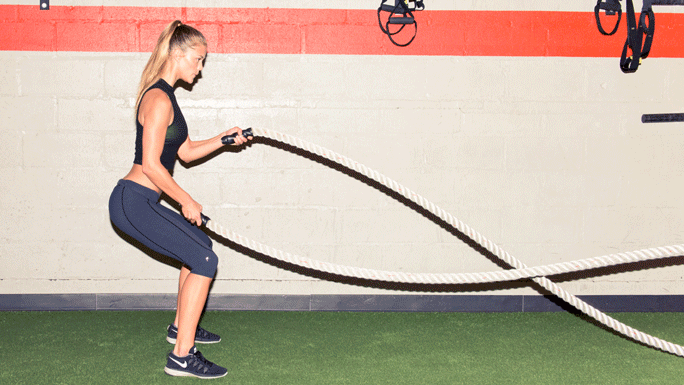How to Know If Your Workout Is Really Working
Just because you sweat or are sore the next day doesn’t mean you had an effective workout. So what does?
14 August, 2019
Fitness
10 November, 2021
As a wellness editor, I’ve tried just about every method of fitness out there. Some I’ve loved and stayed committed to, others have been one-hit wonders. Minus the wonder part. But the question I almost always ask myself after I try a new class or program for the first time is: Did I get a good workout? Just because I sweat profusely in one workout and only got misty in another can’t be the only indicator I should consider. What about soreness? I asked Cov friend, Nike master trainer, and founder of Madeof___ Kirsty Godso to settle the score on what really indicates an effective workout. Here’s what she had to say.
Should you assume that if you sweat during a workout and are sore the next day, it was an effective workout?
“No. This is definitely not always true. You can sweat in almost any workout, especially in the U.S., where many trainers will heat the room for your class so you feel like you’re working even harder than you truly are—but a lot of your sweat is coming from the temperature manipulation.
“Post-workout soreness can be from a challenging workout, but often occurs from not warming up and cooling down properly. We’re all guilty of running out of classes because we ‘don’t have five minutes to stretch.’ What defines an effective workout is an interesting case and highly dependent on what your training goal is, but I like to put it down to a few things:
1. “Did you feel the work in the right places? Quick examples: Did you manage to activate your glutes and your core as opposed to overworking hip flexors, quads, etc.?
2. “Did you challenge your max heart rate and reach some levels of discomfort? This isn’t just in relation to cardio, but also a heavy strength workout or Pilates can push your heart rate to the test.
3. “Did you find some mental escapism and release from the logistics and stress of everyday life? Exercise truly is the greatest therapy.
4. “Did you feel confident in your movement ability?
5. “Did you challenge yourself in different movement patterns? Transverse, sagittal, and frontal plane.
“Too often we praise intensity and extreme measures as a definition of what is an effective workout when, really, these things can be detrimental. It’s more important you sweat from a strategic workout as opposed to subjecting yourself to an anatomical nightmare.”
What are some other interesting factors to look at?
“Heart Rate Variability (HRV) is an incredibly insightful number to look at, especially in terms of recovery. You can easily track your HRV through devices and apps such as Whoop. Your HRV should be high when you’re successfully shifting between sympathetic and parasympathetic nervous states. Many of us are training high-intensity and living high-intensity, which can result in our HRV being lower than it should be because our system is overloaded with stress and isn’t effectively recalibrating. When we don’t have enough time to recover and repair, our body will hold more inflammation, energetic efficiency will be affected, and we start to gear into burnout mode. You can use your HRV as a guide to how much you can push yourself in your exercise that day. For example: If it is on the low side, it’s a good day to take it easier and do activities such as walking, biking, Pilates, and yoga. When your HRV is high and your body is experiencing good recovery, you’re better equipped to take on more challenging workouts, such as HIIT, strength, and conditioning.”
Does duration of workout matter?
“You can get an effective workout in as little as five minutes. It ultimately depends on what your goal is. If you’re doing a HIIT workout and are truly hitting the spikes in your heart rate, where you get into your anaerobic threshold and using the appropriate recovery intervals, you could crush your workout in 20 minutes. What you do with your time is more important than the total amount of time you are in the gym. Strength workouts are typically longer in total duration because they require longer recovery between exercises. Understanding the relationship between time and intensity, and the type of workout you’re doing, is critical to make sure you’re getting the most out of your workouts and the most effective results.”
Should you rely on your smart watch?
“These devices are good for running and HIIT to watch where your heart rate is sitting. Instead of a time-based approach to your workout, you can actually base your recovery intervals off when your heart rate drops back to a certain level, and then you know it’s time to go again. The fitter you are, the faster your heart should come back down. Depending what type of training you’re doing, these numbers will vary. But this is a great scientific way to push yourself to make sure your intervals are timed accurately for you. You also then have some real-time feedback about where your heart rate is sitting for most of your workout, and if you’re truly hitting your max heart rate in the hardest working sections of your training. Whoop is another great tool to use for this, as you can leave the app open, and it will give you a lot of real-time data on heart rate, resting heart rate, max heart rate, and overall strain on the body.”
Want more stories like this?
Why Your Keto Diet Might Not Be Working
Are We Hiding “Diet” Behind “Wellness”?
How to Be More Alkaline